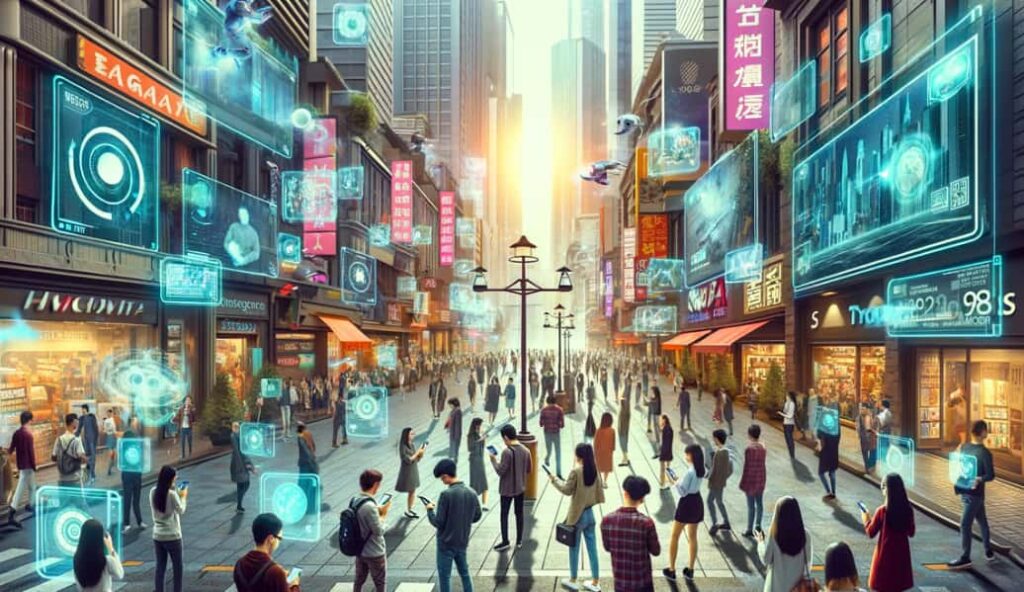Augmented Reality (AR) is no longer confined to the realm of science fiction. It has become a tangible part of our daily lives, transforming the way we interact with the world around us. To truly understand the essence of AR, we need to delve into its characteristics and what makes it a unique and impactful technology.
Before we dive into the characteristics, let’s refresh our understanding of AR. Augmented Reality is a technology that superimposes digital elements, such as images, videos, or 3D models, onto the real world. This overlay enhances our perception of reality, adding an extra layer of information or interactivity.
Characteristics that Define AR
1. Real-Time Interaction
One of the most remarkable and defining characteristics of Augmented Reality (AR) is its capacity to deliver real-time interaction. AR applications possess the incredible ability to respond to changes in the physical world instantaneously. This real-time responsiveness is at the heart of what makes AR so captivating and useful in various applications.
Imagine you’re walking through an art gallery with an AR-equipped smartphone in hand. As you point your device at a specific painting, the AR app instantly recognizes the artwork. What happens next is a seamless fusion of the real and digital worlds. Information about the artist, the painting’s history, and even a virtual tour of the artist’s studio might appear on your smartphone screen. In some cases, the artwork itself might come to life with animations, allowing you to explore its finer details and the artist’s creative process.
This real-time interaction with the physical world is not limited to art galleries. It extends to numerous scenarios, such as using AR for navigation, gaming, and education. When navigating with an AR app, you can receive live directions that adapt to your movements. In gaming, AR enables you to interact with virtual objects superimposed on your surroundings, creating immersive experiences.
In educational settings, AR brings textbooks to life, allowing students to engage with dynamic content that responds to their actions. For instance, solving math problems can become an interactive adventure, and historical events can be reenacted right before their eyes. The instant recognition and responsiveness of AR applications redefine how we interact with the world, making it an invaluable tool with far-reaching implications for various industries and daily life. This characteristic ensures that AR remains at the forefront of technological innovation, continually enhancing our experiences and changing the way we perceive and interact with reality.
2. Contextual Integration
AR thrives on context. It leverages the user’s surroundings to deliver relevant information. Whether it’s providing navigation directions on city streets or offering detailed information about artwork in a museum, AR adapts to the specific context in which it’s used.
3. Enhanced User Experience
AR aims to enrich the user experience. It does this by enhancing the real world with digital elements that are both informative and engaging. This characteristic is particularly evident in fields like gaming, where AR allows users to interact with virtual creatures or objects overlaid on their physical environment.
4. Spatial Awareness
AR technology possesses the capability to understand and interact with the physical space around it. This means AR applications can recognize surfaces, objects, and their positions in 3D space. For instance, AR can accurately place virtual furniture in your living room through your smartphone’s camera.
5. Accessibility
A significant advantage of Augmented Reality (AR) is its ability to maintain a seamless connection to the real world while enhancing it with digital elements. This key characteristic sets AR apart from virtual reality (VR), where users are entirely immersed in a digital environment, often requiring specialized equipment like VR headsets.
AR’s unique accessibility has led to its widespread adoption in a diverse range of applications. Unlike VR, which can sometimes be isolating due to its complete immersion, AR seamlessly integrates with our surroundings, making it suitable for a multitude of scenarios. In the realm of training simulations, AR allows trainees to interact with virtual elements while still being aware of their real-world environment. This is particularly valuable in fields like aviation, where pilots can practice procedures in a simulated cockpit overlaid on their training environment.
In healthcare, AR is used during medical procedures to provide surgeons with real-time visualizations of patient data and anatomical structures. This aids in precision surgeries and minimizes risks, as surgeons can maintain awareness of the patient and their surroundings while accessing critical information. In education, AR serves as a dynamic tool for educators, enhancing the learning experience by overlaying digital content on the physical world. Students can explore complex subjects with interactive models, making abstract concepts more tangible and accessible.
The accessibility of AR extends its reach to fields as diverse as gaming, navigation, design, and entertainment. This characteristic ensures that AR is not confined to a niche market but has the potential to impact a broad spectrum of industries and everyday life, enriching our experiences and connecting us with the digital world in a seamless and meaningful way.
6. Platform Diverse
AR is not limited to a single platform or device. It’s available on various hardware, including smartphones, tablets, smart glasses, and more. This diversity allows users to access AR in ways that are convenient for them.
The Impact of AR Characteristics
Now that we’ve explored the characteristics of AR, let’s examine how these traits impact various industries and aspects of our lives.
Education
In the field of education, AR’s real-time interaction and contextual integration provide students with immersive learning experiences. Imagine reading a history textbook that comes to life with 3D animations of historical events or dissecting a virtual frog in biology class. AR makes learning engaging and memorable.
Healthcare
The spatial awareness characteristic of Augmented Reality (AR) has proven to be a game-changer in the field of healthcare. Its application in medical procedures, particularly during surgeries, offers invaluable benefits that enhance precision and minimize risks.
Surgeons equipped with AR technology can visualize patient data and anatomical structures in real time. Imagine a surgeon performing a complex procedure with a head-mounted AR display. This display overlays critical patient information, such as MRI scans and 3D models, directly onto the surgical field. This means that during surgery, the surgeon can see not only the patient’s physical anatomy but also digital information superimposed on it.
This real-time visualization aids in precise navigation, allowing surgeons to make informed decisions with unparalleled accuracy. It helps identify vital structures, plan incisions, and ensure that no critical areas are compromised during the procedure. In essence, AR technology becomes an indispensable tool for surgeons, reducing the margin of error and improving patient outcomes.
Furthermore, the use of AR in medical training and education allows future healthcare professionals to gain hands-on experience in a safe and controlled virtual environment. This characteristic of AR has the potential to revolutionize medical education by providing students with immersive learning opportunities that enhance their skills and understanding. The spatial awareness offered by AR technology is not just a characteristic but a lifeline in healthcare, safeguarding lives through precision, enhanced training, and ultimately improved patient care. Its integration into medical practices ensures that the benefits of AR extend far beyond entertainment and gaming, impacting lives in the most meaningful way possible.

Retail
Augmented Reality (AR) has become a transformative force in the world of retail, reshaping the way customers shop and interact with products. Its characteristic of enhancing the shopping experience has ushered in a new era of consumer engagement and convenience. One of the standout applications of AR in retail is the ability for customers to virtually try on clothes. Shoppers can use AR-powered apps or mirrors to see how clothing items look on them without physically trying them on. This feature not only saves time but also provides a more immersive and enjoyable shopping experience.
Additionally, AR enables customers to visualize furniture and home decor items in their own living spaces before making a purchase. By using AR apps, customers can place virtual furniture in their homes through their smartphones or tablets, ensuring that it fits perfectly with their existing decor. In physical stores, AR can be harnessed through QR codes. Customers can scan QR codes on product labels to access detailed information, reviews, and even demonstrations. This empowers shoppers with comprehensive product knowledge, enabling them to make informed decisions on the spot.
The retail industry’s embrace of AR demonstrates how this technology is not just a novelty but a practical tool that enhances customer engagement, streamlines decision-making, and ultimately drives sales. As AR continues to evolve, we can expect even more innovative applications that further enrich the retail experience.
Gaming
The gaming industry has embraced AR wholeheartedly. Games like Pokémon GO have demonstrated how AR can blend digital entertainment with the physical world, encouraging players to explore their surroundings.
Navigation
AR-powered navigation apps provide real-time directions by overlaying routes onto the real world. This is particularly useful for pedestrians and cyclists, as it keeps them informed without the need to constantly look at a map.
Design and Architecture
Architects and designers use AR to visualize their creations in real-world environments. This allows for better planning and decision-making during the design process.
Entertainment
In the world of entertainment, AR enhances live performances, movies, and even marketing campaigns. It adds a layer of interactivity and engagement for audiences.
Future Possibilities
The evolution of Augmented Reality (AR) technology is an exciting journey that promises to transform not only how we interact with content but also the breadth of genres it can influence. As AR technology becomes increasingly accessible and affordable, its expansion into diverse genres is inevitable, promising a wider audience and endless possibilities for creative integration.
From the realm of literature, AR is poised to revolutionize the way we read novels and non-fiction alike. Imagine reading a mystery novel where you can visually explore the crime scenes or a history book where historical events come to life through immersive reenactments. AR’s real-time interaction and contextual integration will elevate storytelling to new heights, engaging readers like never before. In the world of art, AR can enhance the experience of viewing and understanding artworks. From famous paintings to contemporary installations, AR can provide insightful information, animations, and behind-the-scenes content that enriches our appreciation of artistic creations.
In educational textbooks, AR can illustrate complex concepts in science, geography, history, and more. It can provide students with interactive models, making abstract or difficult subjects easier to understand. The classroom of the future will undoubtedly incorporate AR as a dynamic learning tool.
The world of entertainment, including movies, theater, and live performances, will see the integration of AR to provide audiences with interactive and immersive experiences that blur the lines between the digital and physical worlds. As AR technology continues to evolve, the characteristics that define it, such as real-time interaction and contextual integration, will remain at the forefront of its impact. The possibilities are limitless, and AR’s journey has only just begun. It’s a journey that promises to redefine how we interact with content and information across a wide array of genres, ensuring that AR remains an ever-evolving force in our lives.
Conclusion
Augmented Reality is characterized by its real-time interaction, contextual integration, enhanced user experience, spatial awareness, accessibility, and platform diversity. These characteristics have a profound impact on various industries, from education and healthcare to retail and entertainment. As AR technology continues to evolve, it will open up new possibilities and redefine the way we engage with the world around us. AR is no longer the future; it’s the present, and it’s here to stay.


Average Rating